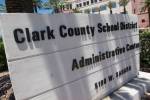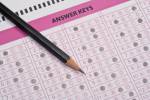Math test challenges spur effort
Clark County School District students overwhelmingly failed their end-of-semester math exams, but scored high enough on state standardized tests to meet the benchmarks of the federal No Child Left Behind Act.
Tim Kanold, a math textbook author and president of the National Council of Supervisors of Mathematics, sees no contradiction.
"You want the local test to be harder than the state test," said Kanold, a former school superintendent for a suburban Chicago district.
Kanold was in Las Vegas on Thursday and Friday to advise a local education committee on ways to improve student performance on math tests.
He's not for a dumbed-down approach.
"You always want to aim high," he said. "You don't want to lower the bar."
The idea is that a challenging local test will better prepare students when the stakes are high, as they are for the No Child Left Behind exams, the state proficiency tests required for high school graduation, and for college entrance exams.
District officials said the poor showing on district exams has reinforced the need to increase the rigor of math in the early grades, to better coordinate the sequence of math instruction from K-12 and to increase communication across the district.
Kanold gave Clark County some credit for giving a districtwide math test. He said it's such a big undertaking for a school system with 47 high schools and more than 300,000 students.
Districtwide tests are "much easier when you only have three high schools," he said.
While it's tough love, district officials said they want a challenging test.
"We can no longer allow students to leave our system requiring college remediation," Clark County Superintendent Walt Rulffes said. "So, rather than take the easy road of preserving the status quo, we created and administered a common test for the purpose of measuring the rigor and quality of math instruction across the district."
Rulffes said the results were disappointing, "but they told us what we needed to know, which will put us on the road to improvement."
Judging by results of the spring semester exams, the road to improvement looks long and steep.
Results did not dramatically improve over results of the fall semester exams.
For instance, about 89 percent of high school students failed the Algebra 1 exam in the spring, compared with the 91 percent failure rate on the fall exam.
In Algebra 2, 78 percent of high school students failed the test, compared with the 86 percent failure rate on the fall exam.
High school students made more noticeable gains in geometry. Only 56 percent of students failed the spring exam, while 88 percent failed the fall exam.
In middle school, failing grades also declined in algebra. The failure rate on the spring exam was 44 percent, compared with the 53 percent of students who failed the fall exam.
Middle school students also did better in pre-algebra, with 71 percent of students failing the spring test, compared with 78 percent failing the fall test.
Students who fared poorly on those exams still could have passed their math classes because the test was just one part of the overall grade.
"This was just one measure," said Jhone Ebert, assistant superintendent for curriculum.
On the state No Child Left Behind exam, about 62 percent of high school students showed proficiency in math. That was a steady gain from 2003, when 43 percent were proficient in math.
Expectations in math education have increased dramatically in the past few years, said Kanold, the national math education expert.
Unlike the premise of the No Child Left Behind Act, it used to be taken for granted that not everybody was going to enroll in algebra or geometry.
Nationally, the trend in math education is to make it "relevant to the YouTube generation" by using more visual cues or concrete examples whenever possible, Kanold said.
Instruction has become more social, too.
Rather than just listening to a classroom lecture, students also are breaking into small groups to work on math problems in collaboration, Kanold said.
Ruffles said he felt validated about the approach Clark County is taking to math education after recently attending a national convention in Oregon for school district chiefs.
He said Clark County is ahead of the curve in adopting the 21st Century Course of Study, which recommends that all high school students enroll in a fourth year of mathematics and a third year of science.
Instead of the usual trigonometry and calculus classes, new fourth-year classes have been developed to give students more options, such as Mathematics of Personal Finance and Topics of Modern Mathematics.
Parents are allowed to opt their child out of the fourth-year requirement but are advised by a school counselor on the necessity of math for their child's future.
Contact reporter James Haug at jhaug@reviewjournal.com or 702-799-2922.























